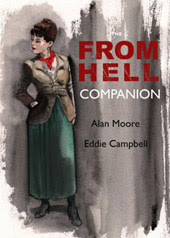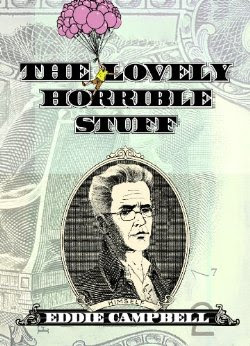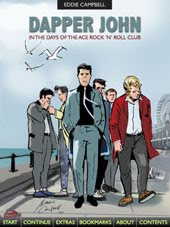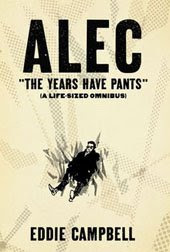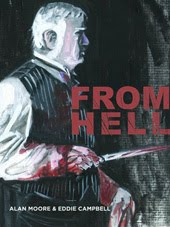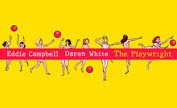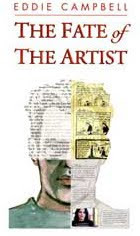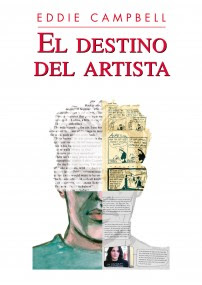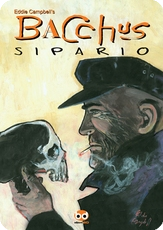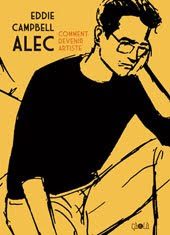A Big Spread-2
A fter yesterday's post about the upcoming Bacchus collection I had a couple of follow-on thoughts. Firstly, all those ugly little creatures were drawn by Pete Mullins. You can see how he's turned this one into a Kubrick reference:

They are called the screaming habdabs:

One of the saddening tendencies of the late comic books is the habit of getting literal. There are some obvious outward signs of this. One such example is the decline of the thought balloon, because although we hear the speech of others, as seen in their speech balloons, we are not privy to their thoughts and so, the theory goes, these should not be made visible. Thus in the more literal-minded comics of our days, such as those from Vertigo, thought balloons have been expunged and replaced by the cinematic technique of the voice-over.
Another comics trick that has largely gone south is the speaking building. This was a staple of the newspaper Illustrated strips, used as a way of setting a scene while simultaneously jumping into the dialogue. It could also be a way of breaking up a static conversation, by cutting to an exterior view. But this had to go. Why? Because buildings don't speak.



I have always liked the talking building:

But the talking building has got nothing on the thinking truck:

***********************************
Just pointed out to me is this interview with Stephen King from May 14 2010 :

They are called the screaming habdabs:
abdabs /ˈabdabz/ (also habdabs)The habdabs have often been read as synonym for Delirium Tremens (or 'giving the invisible man a handshake') an unspeakable condition that I personally hope never to suffer. Tremens is a character in the story, and thus so are the habdabs. The great thing about cartooning in its very essence, is that nothing is literal. Abstract ideas, propositions, medical conditions, can be made into characters. A character can wear all of his guilt in a wretched suit of Tattoos.
▶plural noun
Brit. informal (often in phr. the screaming abdabs) nervous anxiety or irritation.
– origin 1940s: of unknown origin.

One of the saddening tendencies of the late comic books is the habit of getting literal. There are some obvious outward signs of this. One such example is the decline of the thought balloon, because although we hear the speech of others, as seen in their speech balloons, we are not privy to their thoughts and so, the theory goes, these should not be made visible. Thus in the more literal-minded comics of our days, such as those from Vertigo, thought balloons have been expunged and replaced by the cinematic technique of the voice-over.
Another comics trick that has largely gone south is the speaking building. This was a staple of the newspaper Illustrated strips, used as a way of setting a scene while simultaneously jumping into the dialogue. It could also be a way of breaking up a static conversation, by cutting to an exterior view. But this had to go. Why? Because buildings don't speak.



I have always liked the talking building:

But the talking building has got nothing on the thinking truck:

***********************************
Just pointed out to me is this interview with Stephen King from May 14 2010 :
But he fell away from the genre for several years, and in that time the form had evolved considerably, which made writing for the medium a new challenge for even as seasoned a writer as King. “You have to be very humble, and you have to take advice because it’s a new way of seeing, to actually write it is a new way of writing...Poor old Stephen King, made to write in the Vertigo house style. I hope he didn't go away thinking all of comics work that way.
One example:Thought bubbles—those puffy, dotted clouds that were a staple of early comics—have been phased out. “I got this kind of embarrassed call from the editors saying, ‘Ah, Steve, we don't do that anymore.’ ‘You don't do that anymore?’ I said. ‘No, when the characters speak, they speak. If they're thinking, you try to put that across in the narration, in the little narration boxes.’” So King happily re-wrote to fit the new style—though he still laments the loss of the thought bubble. “I think it's a shame to lose that arrow out of your quiver. One of the nice things about the written word as opposed to the spoken word in a movie is that you can go into a character's thoughts. You do it in books all the time, right?”
Labels: A Big Spread, balloons










